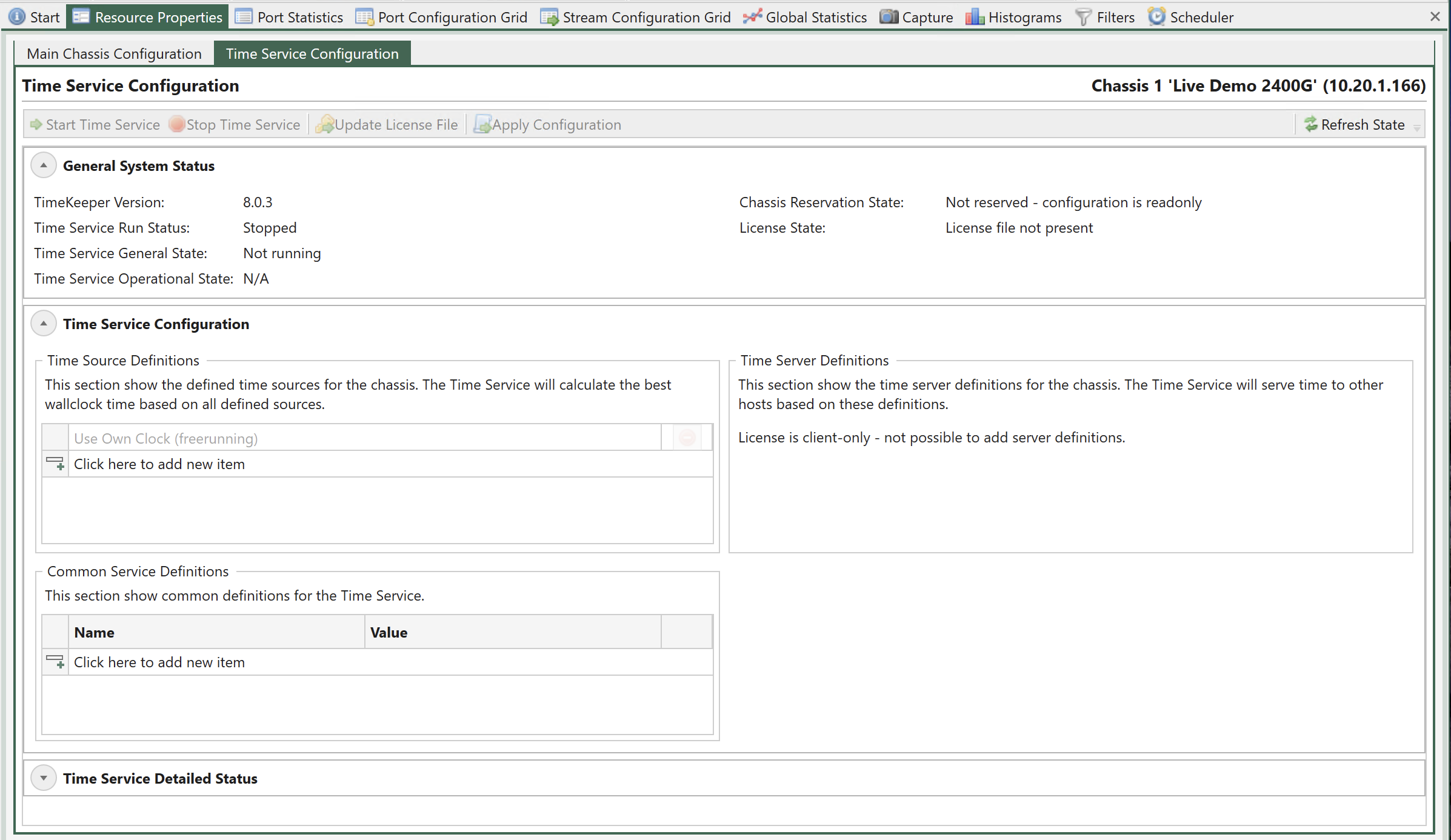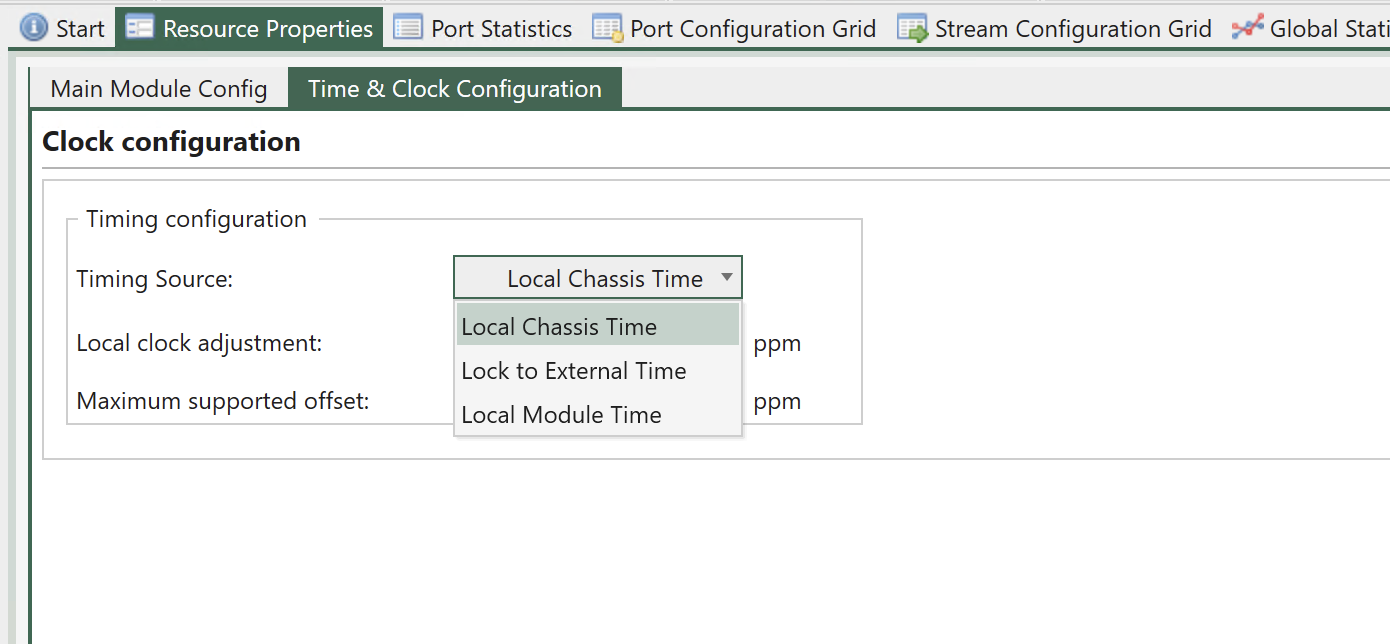Chassis Time Synchronization
This section describes how to setup and monitor time synchronization between multiple Xena test chassis.
Important
This function requires additional software installed on your Xena test chassis. Read Time Synchronization for more details.
Overview
Capabilities
The chassis time synchronization feature enables multiple Xena testers to synchronize their local time to each other. This can be used for various purposes:
One-Way Latency (OWL) measurements between two test chassis.
Synchronized traffic start between multiple chassis.
Accurate timestamping of captured packets in exported PCAP files.
The timing network consisting of your Xena testers may be configured in a very flexible way supporting multiple scenarios:
One tester may serve time to the other testers (and any other host on your network) using any combination of NTP, PTP or RFC 868 TIME *.
Each tester may obtain its own time from an external NTP, PTP or GPS source.
Note
(*) Note that the RFC 868 TIME protocol can only set the time with a precision of 1 second.
About TimeKeeper
TimeKeeper is an advanced time synchronization solution from the company FSMLabs. Xena Networks uses the TimeKeeper solution to keep the local time on each Xena test chassis in sync. The TimeKeeper solution must be installed on each Xena chassis that will participate in the timing setup.
The TimeKeeper solution runs as a separate service on the Xena chassis but is configured and monitored through the XenaManager.
Licensing
Each Xena chassis running the TimeKeeper solution will require an additional software license. The license is time-limited and must be periodically renewed for the TimeKeeper solution to continue to work.
The TimeKeeper license comes in two types: A client-only license that only allows the Xena chassis to obtain its time from an external source and a full license (aka. a server license) that also allows the Xena chassis to serve time to other hosts.
Important
Contact Xena sales for details on the availability and pricing of the TimeKeeper licenses.
TimeKeeper Configuration
The TimeKeeper configuration is accessed as part of the chassis resource property page. If the TimeKeeper solution is installed on the chassis an additional sub-tab named Time Service Configuration will be visible when you select the chassis resource property page, as shown in Fig. 40.

Fig. 40 TimeKeeper configuration
Service and License Control
The TimeKeeper service state can be controlled by the buttons in the top toolbar:
Name |
Explanation |
|---|---|
Start Time Service |
Start the TimeKeeper service if it is not already running. |
Stop Time Service |
Stop the TimeKeeper service if it is running. |
Update License File |
Upload a new TimeKeeper license file to the Xena chassis. |
Apply Configuration |
Apply a changed configuration for the TimeKeeper service. Invoking this option will also restart the TimeKeeper service. |
Refresh State |
The TimeKeeper status will be automatically refreshed every 5 seconds. You can however manually refresh the status by clicking this button. |
General State
The general state of the TimeKeeper solution can be monitored in the General System State section at the top. The following values are provided:
Value |
Explanation |
|---|---|
Version |
The currently installed version of TimeKeeper. |
Run Status |
The current state of the TimeKeeper service (started or stopped) |
General State |
The general state of TimeKeeper |
Operational State |
A more detailed state of TimeKeeper |
Reservation State |
The current chassis reservation state (must be reserved in order to change configuration) |
License State |
The current license state (valid or invalid) and scope (client-only or full server). |
Time Source Configuration
A time source represents the source from which this chassis will synchronize its OS kernel time. The following source types are supported:
An external NTP server
An external PTP server
An internal SpectraTime GPS module (an optional hardware add-on for the chassis). PPS device is not used.
You must configure at least one time source for a chassis. It is possible to configure multiple time sources for a single chassis. The TimeKeeper solution will extract the optimal time based on the contributions from all configured sources.
Time Source Parameters
Parameter |
Explanation |
Applies To |
|---|---|---|
Server Address |
The address of the server to source time from |
NTP Server, PTP Server |
Interface |
The network interface to listen on. If left empty all available network interfaces will be used. |
PTP Server |
Time Server Configuration
If a Xena chassis has been provided with a full TimeKeeper server license it may also serve time to the network, including other Xena chassis in the network. You can configure several different time server definitions for a chassis.
Time Server Parameters
Parameter |
Explanation |
Applies To |
|---|---|---|
Interface |
The network interface to send messages on. If left empty all available network interfaces will be used. |
PTP Server |
License Scenarios
This section describes various configuration scenarios and the required hardware and licenses.
Local Datacenter Scenario
If you have a number of co-located Xena testers in the same physical location and connected to the same local network you can use one of the testers as a time server. This tester will then serve time to the rest of the network, including but not limited to the other Xena testers. The best results will be obtained by using PTP between the Xena testers.
If you have N testers you will need one full TimeKeeper server license and N-1 client-only TimeKeeper licenses. You can configure the time server to synchronize to a public NTP server but if you need a very accurate local time you can optionally equip the time server tester with a SpectraTime GPS module.
Important
Note that the SpectraTime GPS module must be purchased and installed through Xena Networks.
Remote Networked Scenario
If you have two or more Xena testers in remote locations which are connected to the Internet you can then use a public NTP service to synchronize each of the testers. Please note that using a public NTP server will most likely be less accurate than the other solutions.
If you have N testers you will then need N client-only TimeKeeper licenses.
Remote Scenario (no Internet)
If you have two or more Xena testers in remote locations which are not connected to the Internet you can equip each tester with a GPS module.
If you have N testers you will then need N client-only TimeKeeper licenses and N GPS modules.
Important
Note that the SpectraTime GPS module must be purchased and installed through Xena Networks.
Test Module Configuration
By default, each test module will use its own internal clock for latency timestamps and scheduling traffic start. The internal module clock is synchronized with the general PCI clock on the chassis but two or more chassis will of course not share the same clock.
Enabling External Clock Sync
Perform the following steps to enable each test module to synchronize to the TimeKeeper-controlled Operating System (OS) kernel clock:
Open XenaManager and reserve the test module you want to configure.
Set the Latency Reference option to Lock to External Time.

Fig. 41 Enabling external clock sync
The module will now attempt to synchronize its internal clock to the OS kernel clock.
Monitoring Clock Sync Accuracy
You can monitor the accuracy using the following state properties:
Name |
Explanation |
|---|---|
External Clock Diff |
The currently measured difference between the OS kernel time and the local module time. |
External Clock Stats |
Statistics counters:
|
External Clock State |
One of the following:
|
The module clock will usually synchronize to the OS kernel time with approx. 15-20 seconds. But if the OS kernel time is also being adjusted by TimeKeeper you will experience a larger adjustment period.